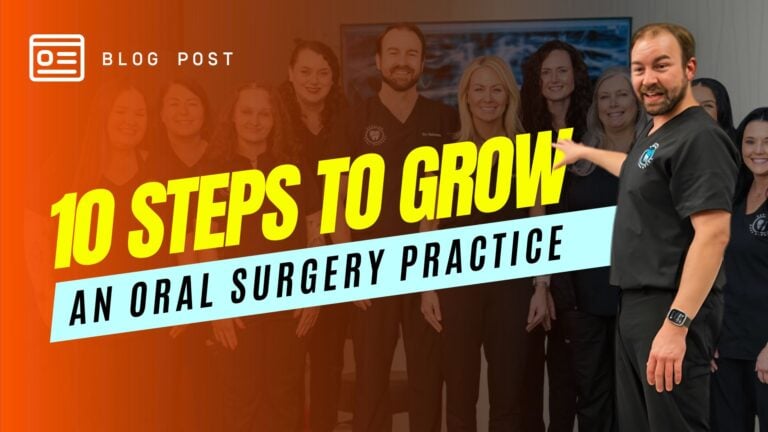Introduction
In today’s digital landscape, an orthodontic practice’s success heavily relies on its online visibility. The majority of potential patients turn to Google to find orthodontists in their area, making search engine optimization (SEO) an essential strategy for growth. Without a strong SEO presence, even the best orthodontists may struggle to attract new patients.
With 2025 just around the corner, orthodontic SEO is evolving to meet the latest search engine algorithms and patient behaviors. To stay ahead of the competition, orthodontists need to implement modern, data-driven SEO techniques that enhance their practice’s online presence. Below, we explore ten powerful SEO strategies designed to help orthodontists boost their rankings, increase website traffic, and ultimately get more patients.
1. Optimize Your Website for Keyword Targeting
A well-optimized website begins with strategic keyword usage. Patients searching for orthodontic services use specific terms, so it’s crucial to identify and incorporate these keywords into your website content. Instead of targeting generic keywords like “orthodontist,” it’s better to focus on long-tail keywords such as “best Invisalign orthodontist in [city]” or “affordable braces near me.”
Keyword placement is just as important as selection. Optimizing your website’s titles, meta descriptions, headers, and URLs with relevant keywords improves your chances of ranking higher on Google. Using tools like SEMrush, Moz, and Google Keyword Planner can help identify high-value keywords that drive patient traffic. A strong keyword strategy ensures that your practice appears when potential patients are searching for orthodontic services in your area.
2. Improve User Experience (UX) for Better Rankings
Google prioritizes websites that offer a seamless user experience. A slow, unresponsive, or confusing website can drive potential patients away before they even book a consultation. Core Web Vitals, a Google ranking factor, measures key aspects of a website’s performance, including page load speed, interactivity, and visual stability.
To improve UX, orthodontic websites should be mobile-friendly, ensuring they display properly on smartphones and tablets. Clear navigation with easy-to-find contact information, service pages, and an appointment booking feature makes it more convenient for users. Additionally, having persuasive call-to-action (CTA) buttons encourages potential patients to schedule a consultation, improving both engagement and conversions.
3. Leverage Local SEO for Maximum Visibility
Most patients search for orthodontists within their city or nearby areas, making local SEO a game-changer. A well-optimized Google Business Profile (GBP) increases visibility in local searches and Google Maps. Practices should ensure their GBP is up-to-date with accurate business hours, location, services, and high-quality photos.
Additionally, incorporating location-based keywords such as “Invisalign specialist in [city]” into your website content can improve rankings. Consistency in your business’s Name, Address, and Phone number (NAP) across online directories like Yelp, Healthgrades, and local business listings enhances trustworthiness and boosts SEO rankings.
4. Build High-Quality Backlinks for Authority
Backlinks, or links from reputable websites pointing to your orthodontic practice’s site, are a major factor in SEO rankings. Google views backlinks as endorsements, signaling that your site is trustworthy and authoritative.
To build strong backlinks, orthodontists can guest post on dental and health blogs, partner with local businesses for cross-promotions, and get listed in industry directories. Quality matters more than quantity—one link from a reputable dental organization holds more value than multiple links from low-authority websites. Over time, a strong backlink profile can significantly improve your rankings and drive more patients to your website.
Unlock The Secrets to Growing a Scalable Practice👇
Ready to take your orthodontic practice to the next level? The Scalable Practice is your ultimate guide to building a thriving, efficient, and sustainable practice. Packed with actionable strategies, insights, and proven methods, this book will help you streamline your operations, attract more patients, and create a business that works for you—not the other way around. Get it for free, today by clicking the link below.
5. Encourage Patient Reviews for Trust and SEO
Online reviews play a crucial role in attracting new patients and improving SEO rankings. Google considers patient reviews as a form of trust, and practices with positive ratings are more likely to appear in local search results. Orthodontists should actively encourage satisfied patients to leave reviews on Google, Facebook, and Yelp.
Responding to both positive and negative reviews professionally demonstrates excellent customer service and builds trust. A practice with a large number of genuine, high-quality reviews will stand out from competitors and attract more patients.
6. Optimize for Voice Search and Conversational Keywords
With the rise of voice search, patients are using natural, conversational queries to find orthodontic services. Instead of typing “orthodontist near me,” they might ask, “Where can I get affordable braces near me?” Optimizing content for these queries improves the chances of appearing in voice search results.
An effective way to do this is by incorporating question-based phrases into blog posts and FAQ sections. Content that mimics natural speech patterns is more likely to be featured in Google’s “People Also Ask” section and voice search responses, making it easier for patients to find your practice.
7. Implement Schema Markup for Enhanced Search Results
Schema markup, also known as structured data, helps search engines understand and display key business information. By adding schema to your website, search engines can showcase your orthodontic practice’s address, phone number, reviews, and services directly in search results.
For orthodontists, using structured data for local businesses, FAQs, and reviews can lead to enhanced visibility. Google’s Structured Data Testing Tool ensures schema is implemented correctly, increasing the chances of appearing in rich search results that stand out from competitors.
8. Utilize Social Media to Drive Engagement
Social media is a powerful tool for orthodontists to connect with potential patients and boost SEO indirectly. Platforms like Instagram, Facebook, and TikTok allow practices to share before-and-after photos, patient testimonials, and educational content about orthodontic treatments.
Regular engagement—such as responding to comments and answering questions—helps build a loyal community and strengthens a practice’s online reputation. By posting valuable content and interacting with followers, orthodontists can drive traffic to their website and increase appointment bookings.
9. Publish High-Quality, Educational Content
Content marketing remains a cornerstone of SEO. Publishing informative blog posts, FAQs, and treatment guides establishes a practice as an authority in orthodontics. Topics such as “The Benefits of Invisalign vs. Braces” or “How to Care for Your Retainer” address patient concerns and attract organic traffic.
Video content is also highly effective. Creating explainer videos on orthodontic procedures and sharing them on YouTube can increase engagement and visibility. High-quality content not only educates patients but also improves search rankings over time.
10. Monitor and Adjust SEO Strategies Regularly
SEO is not a one-time effort; it requires continuous monitoring and adjustments. Tracking website traffic, keyword rankings, and patient conversions with tools like Google Analytics and Search Console helps orthodontists understand what’s working and where improvements are needed.
Regular SEO audits ensure that a website remains optimized for the latest search engine updates. By staying informed about Google algorithm changes and industry trends, orthodontists can refine their SEO strategies and maintain strong online visibility in 2025 and beyond.
Conclusion
In a competitive market, orthodontists must leverage SEO to attract more patients and grow their practice. Implementing strategies like keyword optimization, local SEO, mobile-friendliness, and content marketing can significantly improve search rankings and visibility. By consistently refining SEO efforts and staying ahead of digital trends, orthodontic practices can thrive in 2025 and beyond.




